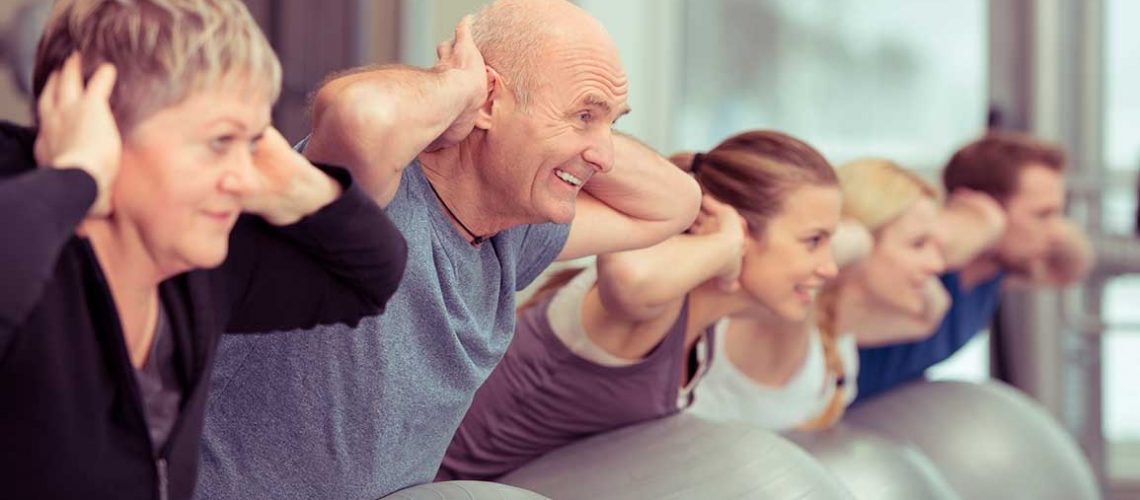Home » Fitness is the Fountain of Youth
Fitness is the Fountain of Youth

The emerging science of epigenetics–changes in gene expression–shows that 80% of how we age is related to our behavior and the choices we make every day regarding food, sleep, exercise and how we manage stress all have a profound impact on how we feel and function.
While aging is a fact of life, the good news is that we can repair our DNA and rejuvenate our body’s cells through healthy habits and lifestyle choices. Studies show that the incidence of chronic diseases including cancer, cardiovascular disease and diabetes, could be reduced by as much as 80% by Lifestyle Medicine with exercise as a key component. We can slow the aging process by adopting an early and regular commitment to exercise, to improve strength, balance, overall conditioning and well-being.
Exercise as Medicine
The benefits of regular physical exercise can be more powerful than any pill, procedure or surgical intervention. Physical fitness has an unparalleled optimizing effect on health by reducing or reversing the risk of obesity, diabetes, cardiovascular disease, cancer, hypertension, depression and anxiety. A regular exercise program boosts immunity and cognitive function, strengthens bones and joints and reduces the risks of falls, all with the benefit of increased well-being and self-esteem. The medical literature reports that regularly practiced exercise (cardio, strength training, flexibility and balance) is the best way to delay and reverse the negative consequences of aging. Research has shown that a person’s degree of physical fitness is an excellent predictor of life expectancy and quality of life. A consistent commitment to exercise that includes frequent activity throughout the day, in combination with a whole-foods, plant-based diet, is the best medicine available to promote healthy and happy aging.
Stay Strong
A strong body is a healthy body. Regular strength training is essential to reduce the degree of sarcopenia—the inevitable loss of skeletal muscle that occurs with aging. Losing muscle mass damages our bones and joints and can seriously impair physical and emotional well-being. It also carries the risk of fatigue, falls and chronic diseases and a loss of independence. The good news is that this condition can be reversible at any age. In fact, in one study, just 8 weeks of a “high intensity resistance training” program (https://www.ncbi.nlm.nih.gov/pmc/articles/PMC6165967) enhanced the physical abilities of frail nursing home residents age 90 and older.
It is never too late to begin a strength-training program with free weights, resistance bands or machines. Exercises that improve balance should be an integral part of your fitness program. We must use and encourage our bodies to support our spine and joints by fine tuning our awareness of how we move through the day purposefully. A daily practice of squats, lunges and strengthening exercises will do the trick. Tai Chi is another gentle and effective method to support a healthy and balanced body – the fluid and gentle movements promote flexibility, strength and postural retraining. Being grounded and strong promotes confidence in the body and imbues a sense of vitality. We can all reap the benefits of rewinding our biological clocks that determine our “functional age” by staying strong. Always first consult a knowledgeable physician, physical therapist or trainer to provide safe guidelines on technique, timing and on how best to advance your program to maximize results and prevent injury.
Stay in the Game, Injury Free
While injuries can happen, it’s important to remember that the risk of NOT exercising is always greater than the occasional muscle sprain or strain, the most common sports injuries. Injuries usually happen when we lift or train too hard or with poor technique, or when we exercise while tired or distracted. Most sports injuries are self-limiting and heal within 6-8 weeks with a regimen of rest/exercise modification, ice, heat and hydration and a healthy diet.
If, however, you do require a physician for your pain or injury you should seek a practitioner who will listen and perform a hands-on, comprehensive physical examination, not merely treat you based on your x-ray or MRI results. You should never accept a pill or procedure without understanding the risks and benefits (Medshadow.org). Remember, pain is a signal and your physician should seek to understand the root cause, support healing and prescribe rehabilitation to prevent future injury (https://huffpost.com/entry/rethinking-the-pain-puzzl_b_9860098). Most sports injuries are mechanical and the optimal treatment should be mechanical as well, such as stretching, osteopathic manipulation, physical therapy and home exercise. All medications, especially opioids but even over-the-counter drugs, come with risks and side effects. Natural self-healing regimens that include an anti-inflammatory diet (Foods that fight pain), hydration, rest and a gentle return to exercise are your best options.
Strategies for Success
We all want to age well, free from the problems caused by deconditioning and inactivity. Your goal should be 150 minutes of moderate to vigorous activity each week. To stay committed to the program, you need to adopt the mindset of an athlete. That means a regular training schedule. Support your fitness regimen by rebooting with sleep, hydration and a whole-food plant-based diet for optimal fuel. Make exercise fun. Schedule it on your calendar. Download an app that allows you to set step goals and monitor your progress. You may find it helpful to move with music or to invite a friend of family member to join in the fun.
The true Fountain of Youth lies in choosing a lifestyle of fitness and food that supports optimal functioning and significantly reduces the rate of chronic disease, frailty, injury and immobility. Physical exercise remains the single best remedy for delaying and preventing the negative consequences of aging.
Make the move NOW to embrace a lifetime of physical activity for a longer and better life. A healthy mind and body is the best health insurance policy.

